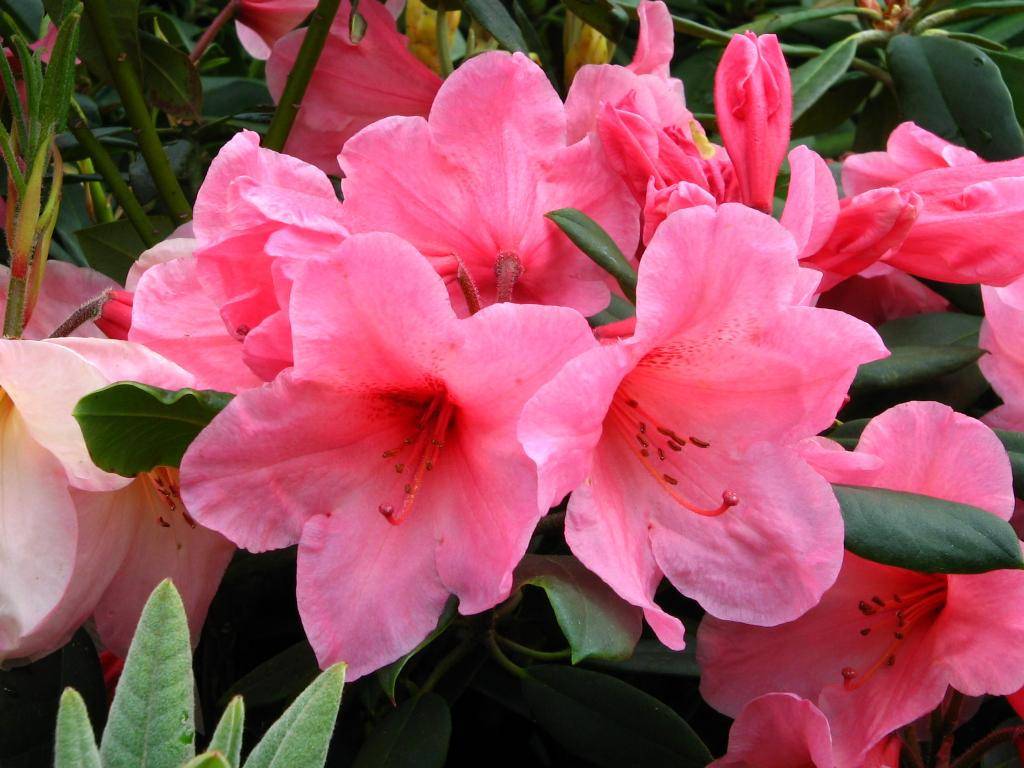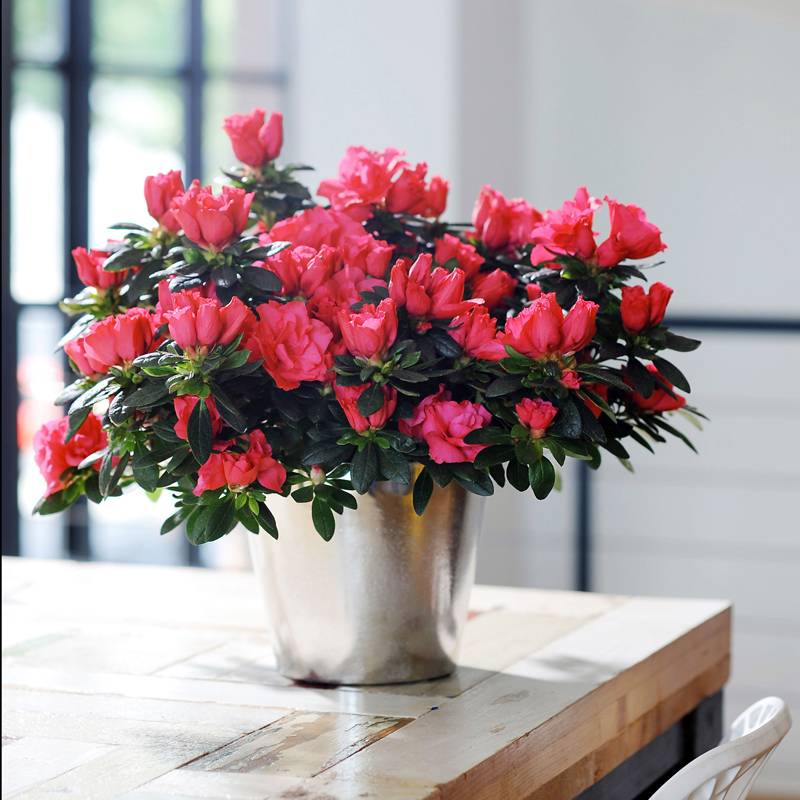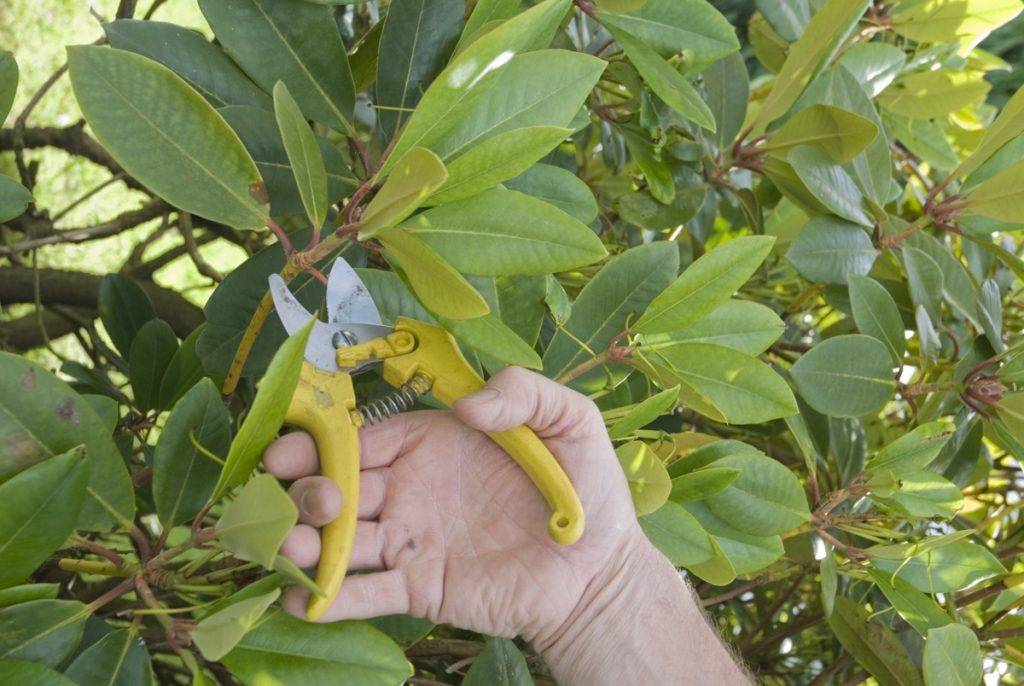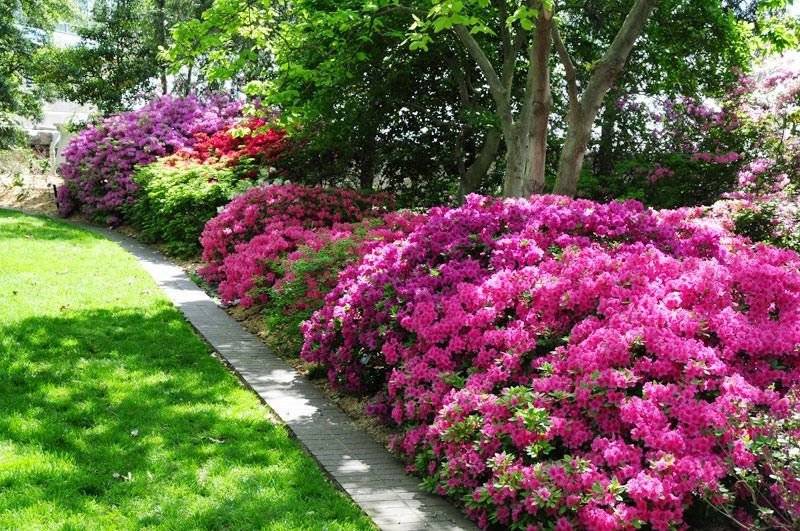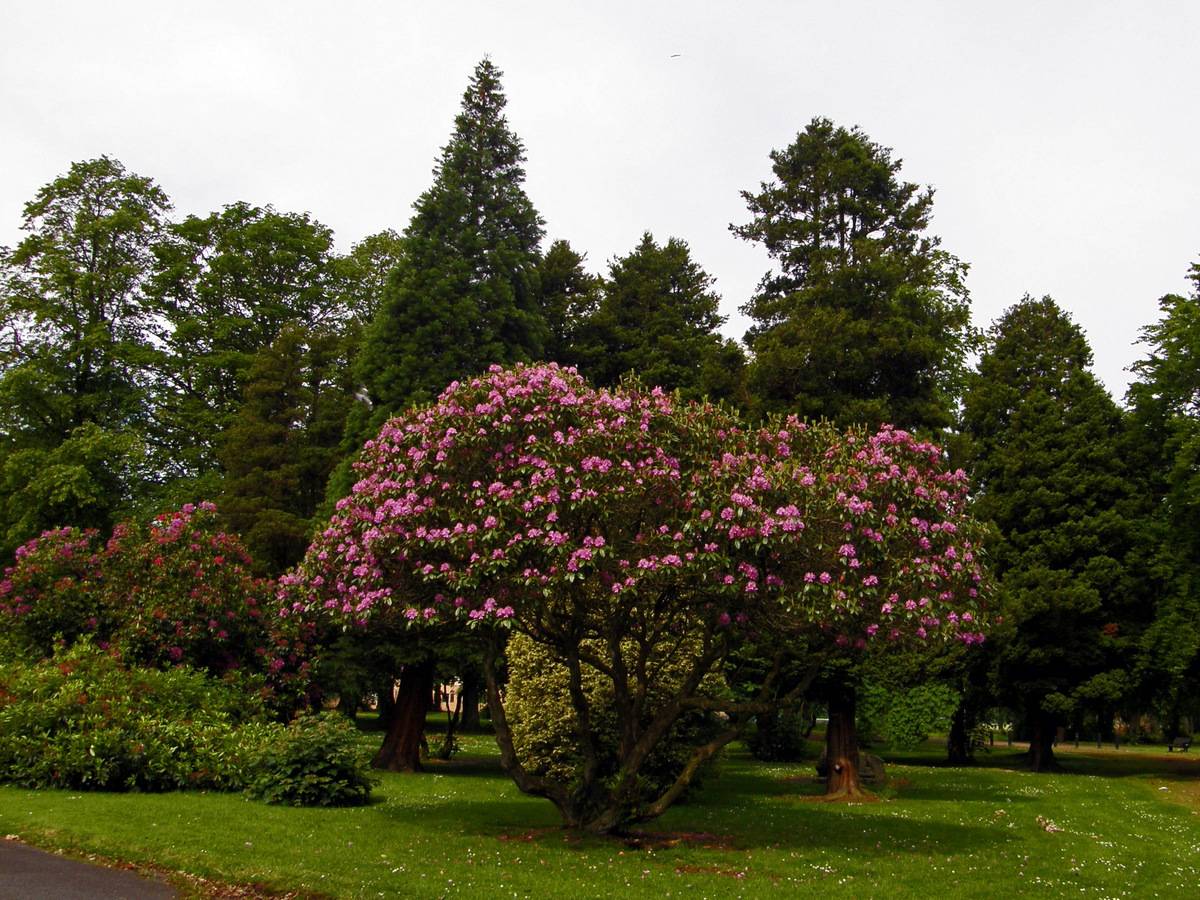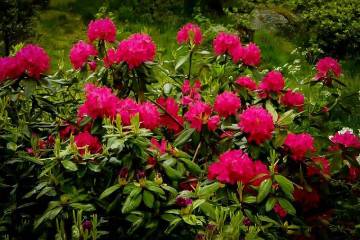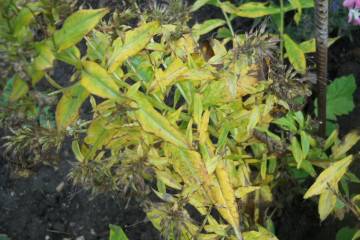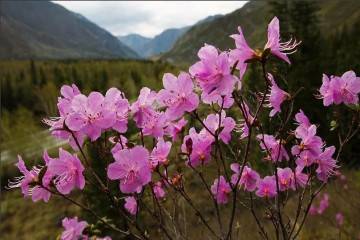Rhododendron has faded: what to do next
Content:
Rhododendron is a flowering perennial, tree-like shrub, beauty and pride of any gardener. He's a room azalea. The flowering of this plant is a colorful sight. At the end of summer, it ends in gardens, in winter - on window sills. When the rhododendron has faded, not everyone knows what to do next with the plant.
Plant features, history
Until the 18th century, rhododendron was considered an oleander, although these are different flowers. In 1763 the naturalist K. Linnaeus divided deciduous and evergreen types of culture. Deciduous called azaleas, evergreen - rhododendrons.
Azaleas - indoor flowers, rhododendrons - garden, park. There is no difference between them, from the point of view of botany.
But shrubs and trees of rhododendrons, of which 40 species out of 1300 grow in Russia, are also divided into:
- Deciduous - drops the crown to frost. In autumn, the leaves turn bright yellow, then crimson. The picturesque colors add additional decor to the gardens.
- Evergreen - does not shed leaves. When it gets colder, they curl into tubes - this is how the plant protects itself from moisture loss.
- Semi-evergreens behave in two ways: some of the leaves are dropped to the cold, some are curled.
The time of flowering, and how long the rhododendron blooms, depends on the species. For example, the Daursky and Vaseya varieties bloom in a leafless state, they are referred to as heather. Rhododendron Yellow, deciduous blooms when leaves appear. The rest of the species in Russian conditions bloom in June-July, bloom all warm times.
After that, the hot season begins for flower growers. After all, pruning faded rhododendrons is part of the agrotechnical measures that are not neglected.
How to prune an azalea after flowering
To obtain a graceful flower and a beautifully formed bush, the azalea is pruned annually after flowering. Without pruning, she refuses to delight the owners with the beauty.
But the procedure is also used for sanitary purposes. Pruning increases the plant's immunity to diseases and pests, stimulates growth. Therefore, it is important to know how to prune an indoor rhododendron in order to get a lush bloom in a year.
The time for this is dictated by the culture itself:
- early varieties (bloom in December-January) are pruned in February;
- medium - (flowering January-March) - in April;
- the late ones (bloom in February-April) are trimmed in May.
The step-by-step procedure looks like this:
- The secateurs are wiped with alcohol.
- Elongated branches are shortened.
- Thin out the middle of the bush.
- Sick, underdeveloped, dry shoots are removed.
- Places of cuts are sprinkled with activated carbon or treated with RanNet.
Together with pruning, the tops of the branches are pinched. As a result, the plant will give additional side shoots.
How to prune a rhododendron after flowering
When the beauty faded away, experienced flora lovers know what to do with the garden rhododendron after its flowering.
Although they also argue whether the plant needs pruning. The fact is that botanists believe that the culture is genetically tuned for the perfect bush.But gardeners are so sensitive to green pets that they once again hesitate to take the pruner in their hands.
One circumstance is added to the arguments of the opponents of pruning. The plant after transplanting, if dug up with an earthen lump, does not need pruning. The roots continue to "work", there is no imbalance between the top (branches) and the bottom (roots). The culture does not suffer from transplantation.
The point in dispute is the positive results of pruning:
- Prevention of shrub diseases. Pests do not penetrate deep into branches and trunks.
- Growth and branching intensifies.
- The flowering and decorativeness of the culture improves.
- Prolongs the life of aging specimens.
If the issue of expediency is resolved, then gardeners who practice annual pruning suggest how to prune the rhododendron after flowering.
Four types of pruning are used according to the averaged technology.
Starting
Do it right away when a new plant is planted. In order for him to settle down in a new place, he needs strength. Therefore, cut short.
The roots grow into the ground and become stronger. This takes all the strength of the plant. As the roots are strengthened, the lower, closest to them, buds come to life. The plant enters into force, starts to grow.
Sanitary
It is carried out as the first spring pruning for deciduous varieties. The fact is that in the spring, deciduous ones show how the bush overwintered. Branches that have not endured frost are ruthlessly destroyed. At the same time, the tips of the shoots are pinched to form young lateral branches.
In summer, stasis after flowering, sanitary pruning is done to evergreen and semi-evergreen species. Cut dry, diseased branches.
Rejuvenating
Used for trees and shrubs after 5-7 years of life. This is the moment when plants are replaced with new ones. But cardinal pruning revives the bush, gives it strength for growth and flowering.
Cut old branches at the root. Broken trunks are trimmed below the break point. If the bark is cracked, it is cleaned off, cut off to a living place.
Rejuvenation is carried out when the bushes grow in excess of what is desired: they shade the beds, buildings, garden paths. In this case, the base of the bush - branches 3-4 cm thick - are not cut out under the root, because the bush may die.
After 3 weeks, dormant buds awaken below the cuts, the plant comes to life, gives side branches.
Formative
To form a decorative crown, protruding branches are cut off. Frail, poorly developed shoots in the middle of the bush are also removed.
With the help of formative pruning, they give the bush any configuration. But most of all the spherical shape suits the plant - the flowering bush looks impressive.
Doubts among novice florists raises the question of whether it is necessary to cut off faded flowers from rhododendrons.
The meaning and purpose of the existence of any representative of the plant kingdom is in the ripening of fruits and seeds. This is "procreation" and culture spends all its energy on it. If you give the fruits of a faded rhododendron to ripen, then next year it will not bloom profusely and magnificently. The plant will be depleted, it will bloom periodically. Therefore, wilted flower stalks must be cut off at the very base.
Formative pruning is done with care, because the stasis under the flower has already formed and new young shoots are ready to grow.
Rhododendron: care after flowering
After the completion of flowering, the forces of rhododendron are directed to the laying of new flower buds and the growth of young shoots. Therefore, care after flowering requires special. It is necessary to care for the crop so that it regains strength for the next exuberant flowering.
Agrotechnical activities are carried out:
- Water regularly abundantly. 10-12 liters of water are poured under the bush. In the heat, they must be sprayed. Irrigation water should have a pH in the range of 4-5 units.Otherwise, it will alkalize the soil, which is not desirable for rhododendrons. Deacidify water with citric and oxalic acid (3-4 g per bucket).
- The inflorescences and seed pods are removed. It is done in hot weather so that the injured place dries out immediately.
- If during flowering they did not fertilize with Kemira, then they do it in July, when the plant will fade. They are fed with ammonium nitrate. The plant is in dire need of nitrogen for the growth of young shoots. Dilute 25-30 g of saltpeter in a bucket of water. An adult bush needs 2 buckets. An already moistened bush is fed so as not to burn the roots.
- They remove weeds, weed, loosen the ground. Air is necessary for the roots of the plant. They are without root hairs. The nutrients from the soil are supplied by the mycelium of mycorrhiza (the simplest fungus), which lives in the cells of the plant. To prevent the mycelium from suffocating, it needs a flow of air.
What fertilizer to use for rhododendrons
Based on the composition of soils suitable for crop growth. It is acidic, therefore, mineral fertilizers with high calcium are given in the spring in small doses.
The fertilizer selection looks like this:
- Targeted fertilization. Suitable for azaleas, hydrangeas. The basis was put in nitrogen, phosphorus, potassium in the correct ratio. Trace elements are added. The composition maintains soil balance during the growing season of the plant. They are brought under adult shrubs from April to August. If the plant has just been planted, it is brought in twice - in April, June. An example of targeted fertilization is Florovit.
- Long-lasting fertilizer. This is potassium with nitrogen and trace elements. The granules of the substances are placed in organic capsules. They gradually dissolve in the ground, release food in doses. Introduced under the plant once, they last up to six months. This is Osmocote Pro, the Floranid Permanent complex.
- Coffee cake. Acts as organic matter, contains minerals and trace elements. It acidifies the soil and, what is important, enriches the substrate with humus.
- Horny meal. Natural fertilizer from the horns and hooves of animals. Improves soil structure, oxygenates the roots. Horn shavings act for a long time.
Preparing rhododendrons for winter
Hybrid varieties of rhododendron are sheltered for the winter. This is a prerequisite for caring for rhododendron.
Regardless of the region of growth, the shrub is prepared for the cold as follows:
- Nutrient composition is added to the soil. These are potassium, iron, colloidal sulfur. So that the flower does not get sick with fungal infections, it is sprayed with copper sulfate.
- Mulch with sawdust, peat.
Next, they decide on the issue of shelter. It is not required in the southern foothills. In the middle and northern latitudes, adapted varieties that grow in natural conditions also do not build greenhouses. Deciduous species tolerate frost without insulation. But for evergreen hybrids, shelter is a must.
From autumn they mulch to a height of 10 cm. When the cold begins, the layer is raised so as to cover the lower branches.
Ways of warming culture:
- Box. After mulching, the plant is covered with a box. In order not to get wet, they are wrapped in foil. Make holes for air. In northern places, the top of the box is covered with spruce branches - mice start in the straw and dry foliage.
- Mini greenhouses. In autumn, metal or plastic arcs are installed. When it gets colder, they cover with agrotex, lutrasil.
- They bend the branches to the ground, sprinkle them with sawdust, leaves, snow.
How to keep a plant dry
The plant suffers from parasitic and non-parasitic diseases. The former are caused by microorganisms, fungi. The latter appear due to violation of agricultural technology.
But the symptoms in both cases are the same: the leaf dries, turns yellow, falls off.
In order to cope with the problem, they look for the cause.
- If pests are found, they are treated with preparations with copper.
- If mites and fungus are not observed, care is impaired. In the spring, brown spots appear from sunburn, temperature changes. The plant is shaded.
- In winter, the plant dries up, it resembles dying off. In fact, the water exchange is disrupted. Prevent with abundant watering before rest.
Another reason for dry leaves is nitrogen starvation. Occurs when the plant lives in sandy soils. In this case, the leaves become smaller, brighten, fall off. The plant is rescued by transplanting. Or they are systematically fed with mineral fertilizers with nitrogen.
Possible errors and their consequences
It is necessary to care for, water, cut the plant in compliance with agrotechnical rules. Errors lead to disease and death of the plant:
- Priming. Inappropriate soil acidity, salt, excessive or insufficient soil moisture lead to chlorosis. The shrub turns light green, then yellowish green. Then it dries up and dies.
- Humidity of air and soil. With insufficient humidity and sub-zero temperatures, the plant is damaged and dies. Excess moisture and poor drainage lead to fungal infections.
- Shine. Disadvantage - the shoots are stretched, decorative qualities are reduced. Excess - sunburn.
- Nitrogen starvation. If the foliage brightens, becomes shallow, young shoots do not grow - the culture does not have enough nitrogen. Such starvation leads to the loss of leaves of previous years, although the leaf of an evergreen rhododendron lives for 4 years. By the middle of summer, only the leaves of the current year will remain. The situation is corrected by urgent nitrogen fertilization.
Rhododendron and azalea are great flowers to decorate your home and garden. But they require the care and attention of the owners. Knowing the preferences in soils, observing the rules of pruning, watering and feeding regimes, gardeners can easily grow a plant, and then admire the incredible flowering, riot of colors every season.
